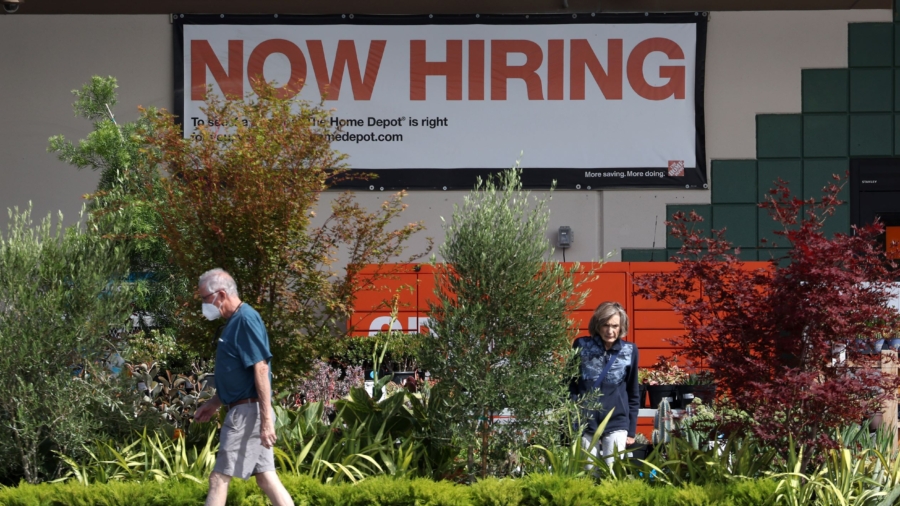The U.S. economy added 261,000 new jobs in October, down from the upwardly revised 315,000 in September, according to the Bureau of Labor Statistics (BLS). This topped the market estimate of 200,000.
The unemployment rate ticked up to 3.7 percent last month, up from 3.5 percent in September. The labor force participation rate edged down from 62.3 percent to 62.2 percent.
Average hourly earnings eased to 4.7 percent year-over-year, down from 5 percent. This was in line with market expectations. Average weekly hours were unchanged at 34.5.
The U.S. labor market data had been mixed heading into the October jobs report.
Earlier this week, the number of new job openings increased to 10.717 million in September, up from 10.28 million in August, according to the BLS. This topped the market estimate of 10 million.
The number of people who quit their jobs eased slightly to 4.061 million in September, down from 4.184 million.
Data from Challenger, Gray & Christmas found that U.S.-based companies announced 33,843 job cuts in October, up 13 percent from September. It was also the highest reading since February 2021, driven by tech firms, services, and warehousing. In the first ten months of 2022, employers announced nearly 244,000 job cuts.
“We are beginning to see more job cut activity in the fourth quarter, historically when the bulk of cuts occur, as companies finalize budgets and plans. Many companies are anticipating a downturn, and with a still-tight labor market and the Fed’s rate hikes, more cuts will be on the way as we enter 2023,” said Andrew Challenger, senior vice president of Challenger, Gray & Christmas, in a statement.
Meanwhile, private businesses added 239,000 new jobs in October, up from 192,000 in the previous month. The reading also came in higher than economists’ expectations of 195,000. Most of the hiring occurred in the services-providing sector, led by leisure and hospitality (210,000) and trade and transportation (84,000).
“This is a really strong number given the maturity of the economic recovery, but the hiring was not broad-based,” said Nela Richardson, the chief economist at ADP, in a statement (pdf). “Goods producers, which are sensitive to interest rates, are pulling back, and job changers are commanding smaller pay gains. While we’re seeing early signs of Fed-driven demand destruction, it’s affecting only certain sectors of the labor market.”
Initial jobless claims fell to 217,000 for the week ending Oct. 29, under the market consensus of 220,000, the Department of Labor reported (pdf). Continuing jobless claims increased by 1.485 million, while the four-week average, which strips week-to-week volatility, slipped to 218,750.
In other labor news, the BLS noted that unit labor costs eased to 3.5 percent in the third quarter, down from 8.9 percent in the second quarter. Non-farm productivity rose 0.3 percent, up from the 4.1 percent contraction in the previous quarter. This was below the market estimate of 0.6 percent.
Will the Fed Kill the Labor Market?
Despite its intentions to cool the U.S. economy, and it has in many ways, the Federal Reserve has not eradicated the strong job market. From higher wages to an exceptional supply of jobs for unemployed workers, the central bank has struggled to douse the hot labor situation, which could make it more difficult to curb inflation.
But some market experts think that unemployment will start to pick up following the Fed’s fourth 75-basis-point rate hike at the November Federal Open Market Committee (FOMC) policy meeting.
“The chances of a sharp rise in unemployment in the U.S. over the coming year are high,” said Jill Gonzalez, a WalletHub analyst, in a report. “The unemployment rate was expected to average 3.7% this year before rising to 4.4% and 4.8% in 2023 and 2024, respectively. That number has not been reached yet, so we should expect it fairly soon. Once unemployment does start to rise, the Fed should be able to pull back on its aggressive rate increases.”
Meanwhile, in a letter sent to Fed Chair Jerome Powell (pdf), Democratic senators, including Sen. Elizabeth Warren (D-Mass.), asked how many job losses should the American people brace for in the coming months.
“We are writing to express concern and request additional information about the implications of the Federal Reserve’s (Fed’s) most recent economic projections, its intention to continue raising interest rates at an alarming pace, and your disturbing warning to American families that they should expect ‘pain’ over the coming months as the Fed takes ‘forceful and rapid steps’ to ‘get supply and demand back into alignment … by slowing the economy,'” they wrote.
Powell will have until Nov. 14 to respond to the letter.
From The Epoch Times

